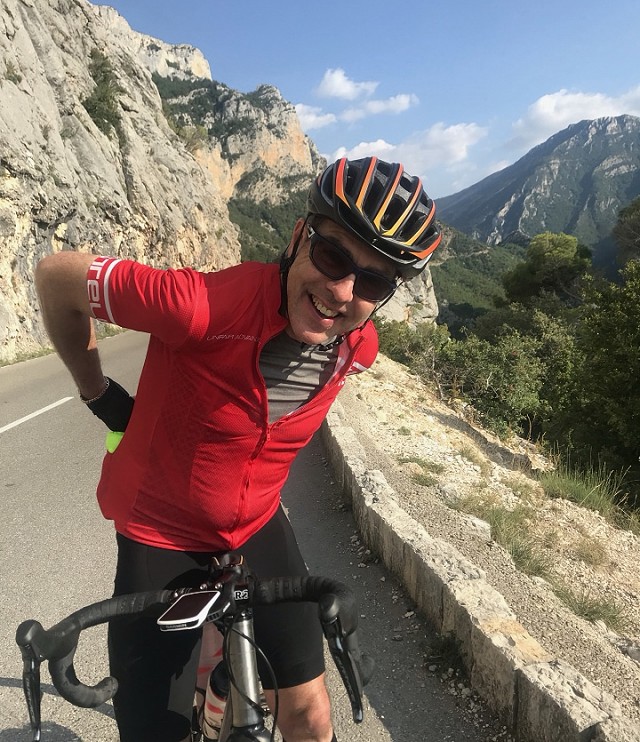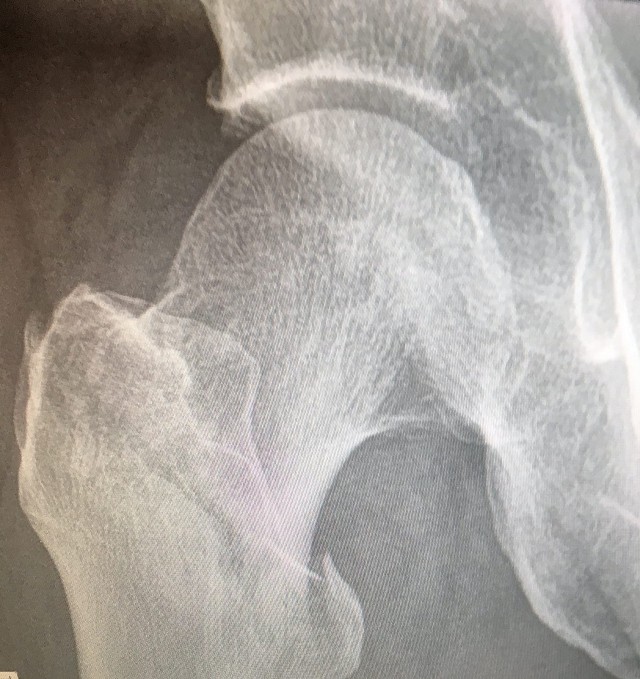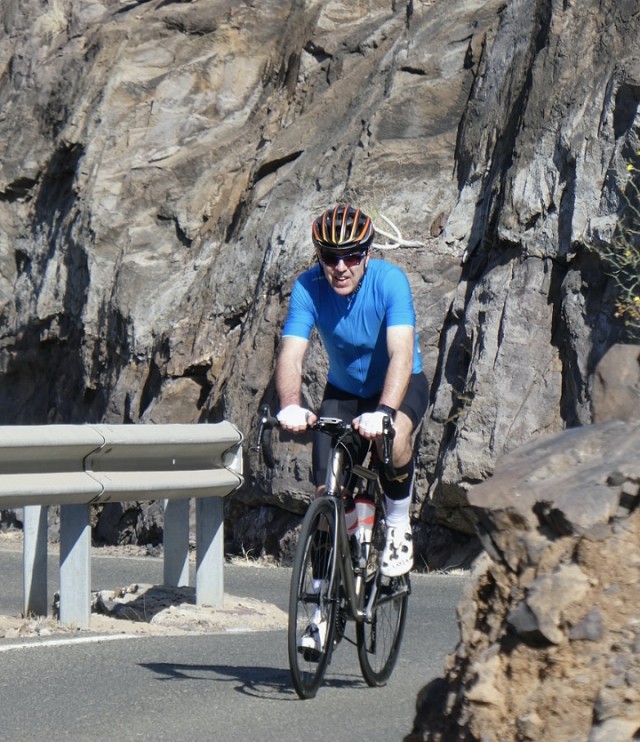The Recovery
You had surgery to repair the damage. What did this entail?
The operation took about 2 hours (l think). A plate was attached to the hip joint and secured in place with screws. It is a permanent fix and l won’t require any further surgery. Obviously, the surgeon had to cut through my muscle which caused natural trauma to the site thus effecting the recovery further.
I was advised to take care of the wound and not disturb the dressing as l had suffered a significant amount of gavel rash in the accident. Although it was cleaned during the operation, there was risk of infection which would cause major issues if it got to the metal work. This was probably the most distressing part as l know that complications following surgery can be disastrous. When the dressing was removed at my local GP surgery two weeks later the nurse was extremely pleased with the way in which the wound had healed.
After the surgery how long was it before you were up and about?
The Occupational Therapy team got me out of bed the next morning, as a key part of the healing process relies on pressure being put on the injured leg. l had to use my left foot under my right leg to move it across the bed and it was quite painful getting my leg over the side of mattress. It really was a matter of having to learn to walk again with the aid of a zimmer frame, but l guess it’s like riding a bike!
When they introduced me to my crutches walking became easier. For a few days l needed both, but l was soon able to use just one crutch at home. Within a couple of weeks l just used one outdoors then shortly after l was able to walk unaided.
How long was it until you were back on the bike riding after surgery? Was this a surprise?
A key part of my recovery was down to my physiotherapists. I was able to get 10 treatments via my employer’s private health insurance and this set me up really well. Initially l attended a weekly session and l routinely did two or three sets of exercises every day at home. As a result, the speed of my recovery was quicker than expected. They then went out to fortnightly appointments as my recovery was well above average. I also attended the NHS physio so that they could also check on my recovery. It’s fair to say that they were really surprised with my fast development.
I went back on the turbo trainer 10 days after l was discharged from hospital. However, I wasn’t too sure if l could get back on the bike as getting my right leg over the saddle was an unknown, l then didn’t know how the leg would respond and finally, l needed to get the bike up to 20 mph to calibrate the trainer. I was pleasantly surprised that l had no issues and l was able to enjoy a short 5-minute spin with no pain or side effects. As regards getting back on the road, l made a pact with my physio that l would wait until Easter.
Were you able to do any other activities to help maintain your aerobic fitness whilst you were unable to cycle?
My rehabilitation program was an essential part to maintaining my fitness. Initially this involved simple leg exercises, but as the muscle strengthened l was able to introduce light weights and higher resistant bands. It’s fair to say that walking really helped as it got me mobile and out of the house. There really is only so much daytime television that l can watch!
My wife was a great support throughout and we often went out on walks with our dog Jenson. I couldn’t take him on the lead for a couple of months and when l could l used two leads as he’s an Eurasier and 26kg of muscle and fluff. Once l had passed the point of needing crutches I was soon able to do more demanding exercises such as mountain climbers and squat jumps.
At what stage did you decide that you were going to go all in not only to recovery but use this as a positive so you came back even stronger than before the accident?
My physiotherapist recommended that l should do some gym strengthening work as l had exhausted the exercises she recommended. I contacted a local gym and went along for a discussion with the principle fitness instructor. This turned out to be a very frank and, to a degree, disappointing insight to what he thought about physiotherapists. In fairness, he had suffered several injuries playing rugby over many years and had spent a great deal of time rehabilitating; however, I got the impression that he was more interested in how much l could spend each month with one of the fitness advisors. I gave this some thought and later emailed him with an indication of what l could go to. Interestingly, l didn’t get a reply despite sending two further emails, so l had to consider an alternative solution.
Fortunately, my son is a gym instructor and, coincidently before the accident, l had put some exercise equipment in my garden’s summer house. Although he lives in 200 miles away, he was able to design a weight training programme for me via an APP. This ensured he could keep a check on my progress and adapt it as l progressed. I started with squats (literally the 20kg bar), planks, kettlebell swings and some stretching exercises, which focused on my quads and glutes as well as my core strength. I have now progressed to a wider range of weights and core exercises, which includes squats (67.5kg) and deadlifts (55kg). I start and finish each session with a 6-minute warm up on the turbo.
Was it helpful having a cycling coach at this stage? Did this help your comeback?
Definitely, yes. It’s fair to say that initially neither of us knew how my recovery would go; however, l was determined to keep normal contact with Ray. We maintained our weekly phone calls and once l got back onto the turbo trainer he developed a series of short, low intensity sessions for me. As the strength in my thighs improved so he increased their duration and intensity. The one thing we didn’t change was my FTP level, as that gave me a baseline to work from and l could easily gauge how my recovery was improving.
I know that as part of your rehabilitation you had a lot of physiotherapy. How important was this to your longer term recovery?
My physiotherapist played a vital role in my long-term recovery. Initially l had weekly sessions with plenty of advice and feedback on my progress. As my recovery was progressing quicker than anticipated, the sessions became fortnightly. It was essential that l did the recommended exercises each day, which she indicated most of her clients don’t do.
You decided to carry on with strength and conditioning training after the physiotherapy ended. What made you decide to do this and how has this benefited you?
I recall the conversations we had previously when l was in the Alps about the value of introducing strength and conditioning training into cycle training schedules. I had never really got into them but, by default, the injury meant l now had to do them and l could see the benefit they were having on me. To a degree they have now become second nature in my training regime and my son is keen to keep me progressing too. I aim to complete 3 sessions a week and they each take just over the hour.
I can’t over emphasise the importance of getting professional advice before introducing weights into a training schedule, as the risk of injury is high if too heavy loads are attempted or the wrong technique deployed.
Were there other medical professionals involved along the way that helped you to make a full recovery?
Yes. I have a friend who is an Osteopath. He made the observation that given my fitness level before the injury, if there was ever an example of pre-rehabilitation, then l was it. The point he was making was that regular cyclists are in a good physical and mental condition to be able to cope with set-backs.
I utilized the physiotherapist and osteopath at work to help with some massage and muscular strains which l occasionally experienced. I also maintained contact with the NHS physiotherapy department to ensure they could keep a check on my progress too. I saw them a few times and it’s fair to say they were surprised at the speed of my recovery.
Was there ever a point in your recovery when you thought you’d not get back to your previous level of fitness? How did you deal with this?
There were times when l was frustrated and impatient as, despite the speed of my recovery, l wanted to do more. I had to keep focus on what full recovery would look like. At my 6-week post op assessment my consultant stated that the bone had healed, which was in about half the time l was originally told. He then emphasised that, regardless of age, it’s possible to build up muscle until you die although it’s more challenging in older age.
He did confirm three things: firstly, l suffered a high impact injury, which had compressed my thigh muscle; secondly, l had experienced a degree of muscle wastage since the injury; and finally, he had caused major trauma by cutting through the muscle to get to the fracture. With that he told me l was discharged and to go away and carry on doing what l was doing because my recovery was text book.
As your recovery progressed how did your cycling training programme look. Was it a gradual build up of duration and intensity?
As mentioned previously, l kept my FTP at my pre-accident level so that l had a baseline to work from. Yes, it was a gradual build up of duration and intensity on the turbo trainer. I kept away from VO2 Max segments until l felt l could cope. The advantage of working with Ray was that l had to keep a daily diary on Training Peaks, so he had full visibility on how l was feeling.
I recall the challenge l had during the British Cycling 20 minute warm up period, particularly the stage where it ramps from 55% to 105% over 8 minutes. For a few weeks l plateaued around 75% to 80%, as my leg strength just couldn’t cope with the excess demand. It was a major achievement when l eventually held it all the way through to 105%.
Did you struggle psychologically with the reduced load and training intensity or embrace it as a step in the right direction?
I had to develop a different mindset. There was no way l could achieve my previous targets, it had to be a reduced load and training intensity. This was the only way l was going to get back to full fitness.








